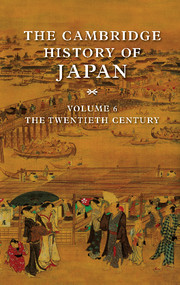2 - The establishment of party cabinets, 1898–1932
from PART I - DOMESTIC POLITICS
Published online by Cambridge University Press: 28 March 2008
Summary
The year 1924 marked a turning point in the history of Japanese domestic politics. In January, Kiyoura Keigo, the incumbent president of the Privy Council, was nominated as prime minister and chose all his cabinet except for the military service ministers from the membership of the House of Peers. The House of Representatives had been by passed in the selection of cabinets since the fall of the Takahashi Korekiyo cabinet in June 1922. Angered by this, the leaders of the three major opposition parties in the lower house – Katō Takaaki (Kenseikai), Takahashi Korekiyo (Seiyūkai), and Inukai Tsuyoshi (Kakushin Club) – met in February 1924 to organize a united front to bring down Kiyoura's “cabinet of peers.” Because the first Labour Party government had been organized in England just a few weeks before, the general public as well as many party politicians felt that the Kiyoura government was swimming against the tides of history.
In the general election of May 1924, the three-party coalition, brandishing the slogan of “protecting constitutional government,” won a majority in the House of Representatives. Faced with the prospect of intransigent opposition in the lower house, Kiyoura chose to resign. In June the three opposition parties formed a coalition cabinet under the premiership of Katō Takaaki, president of the Kenseikai, the plurality party in the House of Representatives. The formation of this “cabinet to protect constitutional government” (goken sanpa naikaku) was of great significance. For the first time in modern Japanese history, the result of a general election, that is, a change in the majority in the House of Representatives, had brought about a change of cabinets in Japan.
- Type
- Chapter
- Information
- The Cambridge History of Japan , pp. 53 - 96Publisher: Cambridge University PressPrint publication year: 1989
References
- 3
- Cited by

